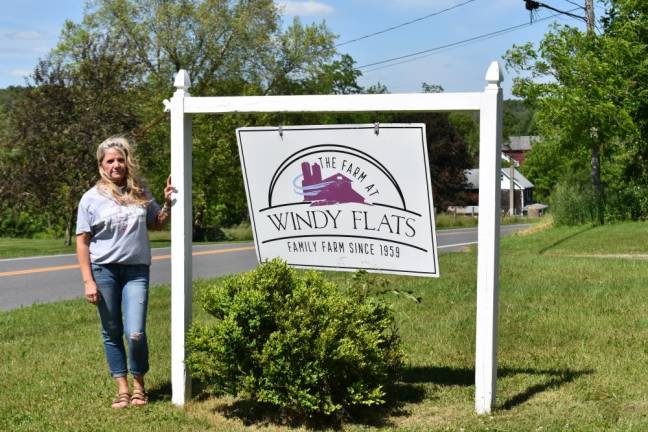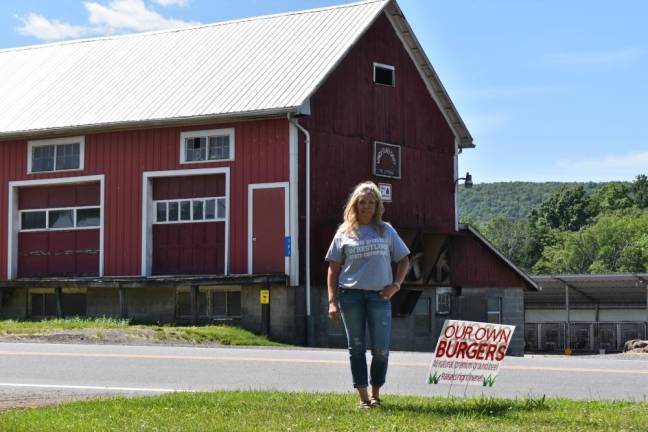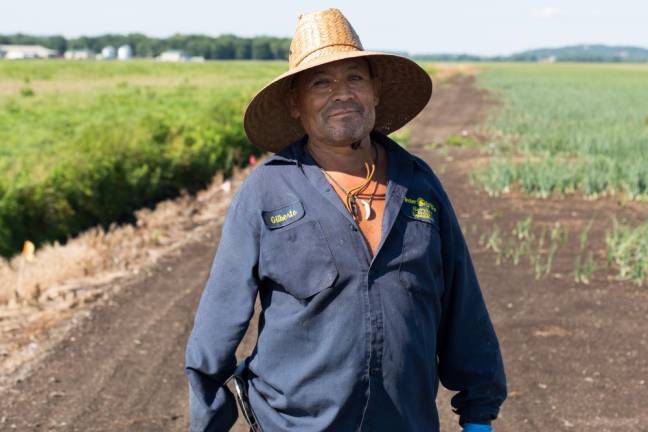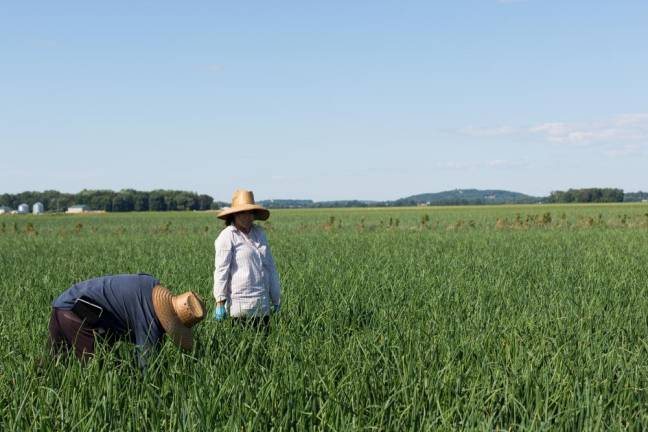As mercury rises, workers may see first workplace heat standards
CLIMATE. ‘The farmers don’t want their workers to get sick and drop in the field either, but it’s hard when you have the harvest.’






Last August, Charles Ellis, a 63-year-old construction worker with a heart condition, was using a hammer to unclog corrugated hosing as part of a team excavating and prepping a construction site in Stony Point, N.Y.
Mid-afternoon, as the heat index hovered near 87 degrees, Ellis started showing signs of heat-related illness. He died at the hospital.
His employer was fined $8,067 for failing to protect workers from the hazard of high heat - which was exacerbated by heat-generating machinery - while doing moderate manual labor, wearing flame resistant overalls, hard hats and face shields, according to the federal Occupational Health and Safety Administration violation.
As the country heads into what may be the hottest summer on record, the Biden administration on July 2 announced the first set of federal guidelines to proactively protect workers like Ellis from extreme heat on the job. If finalized, the rules would cover 36 million employees, including construction, farm, postal and manufacturing workers.
But the new rules face an uncertain future. The regulations won’t be final until at least 2026 and could be rolled back.
In the meantime, workers have been adjusting however they can.
“Some of the farmers are changing their hours. You can see them; they’re harvesting later,” said Katherine Brieger, executive director of the Warwick Area Farmworkers Organization, explaining how farmworkers have been avoiding the worst of the heat during the farm sprint. “You’ll see big lights coming out, sometimes really late at night, like 9 o’clock.
“You know, the farmers don’t want their workers to get sick and drop in the field either, but it’s hard when you have the harvest,” Brieger added.
As temps rise, so does death toll
Last year, the hottest on record, saw 2,300 heat-related deaths in the United States, more than triple the yearly average between 2004 and 2018, according to the Centers for Disease Control and Prevention.
The number of workers who died of heat exposure increased 19 percent in 2022 from the previous year to 51, according to the Bureau of Labor Statistics.
Construction is the industry that poses the greatest heat hazard, accounting for more than a third of occupational heat-related deaths between 1992 and 2022, according to the federal Environmental Protection Agency.
“Weather is a huge, huge factor with us, especially the last couple years, it’s been so brutal,” said Jeffrey Diorio, business manager of Laborers’ Local 17, a union of about 800 construction workers covering Orange, Ulster and Sullivan counties in New York.
Years ago, it would get really hot about 1 p.m., and workers would have a handful of uncomfortable hours to get through. Now, the heat index has often hits 90 by the 9 a.m. start of a workday, said Diorio, who’s been in the construction business for four decades.
Though heat is far from a leading cause of injury on work sites, “it is a complaint” of union members, he said. “They’re always asking, ‘What is the law?’ because there really is none. So basically you’ve got to save yourself. If you gotta go get water, go get water. If you need to take a break, take a break.”
Contractors are supplying water, said Diorio, but for some, that’s it.
“We’ve had a lot of issues with people not quite passing out but basically seeing stars,” he said.
Others become disoriented, which can amplify other hazards in an industry such as construction.
“I’m not saying our contractors are wrong, but there is no laws. Some are there to make a dollar, and they want to get x amount of work done in a short period of time,” he said. “We’ve had a couple guys pass out, and the ambulance came and everything. You’re working on the middle of the highway; if you’re blacktopping, it’s like 400 degrees right by the machine.
“We got all kinds of classes for safety, but there is no class for heat,” Diorio added. “If a contractor doesn’t give ‘em enough water, there’s issues. Sometimes it don’t hit ‘em right away. It’s a couple hours later, they just feel sick, they don’t want to eat, they’re just dehydrated.”
It’s not only outdoor workers who toil in intense heat. Indoor workers, such as those in warehouses, factories and kitchens, often do too.
A 57-year-old commercial bakery worker passed out in the parking lot in Bellmawr, N.J., in July 2020 and died on his third day on the job. He’d been wearing two cloth smocks over his street clothes in a production area that reached a heat index of 106 degrees. The fans had been removed because of COVID concerns; his body temperature was 105 degrees.
Last summer, OSHA stepped up heat-related inspections under an “emphasis” program that targeted workplaces in industries prone to extreme heat. The agency’s 5,000 site inspections since 2022 are a more proactive measure than the post-incident investigations it also conducts.
But until the new rules take effect, the agency is handcuffed by having to rely on the general duty clause, requiring companies to maintain workplaces free of hazards, rather than a specific, enforceable regulation like those in established categories, such as fall protection.
States chart their own course
In absence of a federal rule, five states have heat protections for workers. California became the first to pass heat standards in 2006, after the death of a 53-year-old worker who had been picking grapes for 10 hours in temperatures that topped 100 degrees. Washington, Minnesota, Oregon and Colorado followed suit.
Florida and Texas, two of the country’s hottest states, have gone in the other direction, passing legislation preventing local governments from requiring heat protections for outdoor workers.
New Jersey is hammering out workplace heat rules; the second East Coast state after Maryland with pending legislation. Introduced in January, the New Jersey bill, which would require the state to establish a heat stress standard by June 1, 2025, has advanced out of both chambers’ labor committees but not without meeting opposition from business groups that argue the new rules would contribute to a hostile business climate.
In addition to the standard water, rest and shade, the bill would require employers to limit hazardous heat exposure through practices such as rotating employees, postponing non-urgent tasks until after a heat wave, and scheduling work earlier or later in the day. Any employer who violates the heat-stress standards would risk fines of up to $5,000 and possible jail time.
The New Jersey Farm Bureau voiced its opposition during the hearing, calling the rules impractical, costly and oriented to industrial workplaces that do not fit agricultural circumstances.
New Jersey lawmakers have been meeting with farmers, such as Holly Sytsema, president of the state Board of Agriculture, as they shape the new rules.
Sytsema and her husband raise cattle for dairy and meat at the Farm at Windy Flats in Wantage, a fourth-generation farm.
The state’s farmers have been managing increasing heat for years, she said. “Farmers are already providing extended break periods, earlier start times, which then of course lead to earlier leave times to get the work done before the brunt of the heat during the day,” she said. “Cooling stations are provided on quite a few farms and worker safety is paramount. Farmers want to keep their workers healthy so that we can all work together to get the jobs done that are a necessity, regardless of the temperature.”
Farming by nature is arduous work, but farmers are “resilient and very proud of what they produce.” “Working together with legislators to get the right balance and language will benefit everyone,” she said.
Unheeded calls for heat standards
New York, New Jersey and Pennsylvania, lacking state-level heat standards, joined a coalition of attorneys general calling on OSHA in February to set emergency temporary heat standards for farmworkers and construction workers by the spring.
“Farmworkers and construction workers are disproportionately vulnerable to heat stress due to, among other things, their work environments, the physical nature of their work and prevailing socioeconomic factors, such as language barriers, limited access to health care and wage structures that disincentivize breaks,” New York Attorney General Letitia James write in the February petition.
The temporary standards didn’t happen. The new proposal from OSHA marks a watershed move from an agency that has for decades ignored similar requests.
For workers feeling the heat now, a two-year wait for rules that may or may not come to pass seems like a long, potentially dangerous delay.
“I think it should go into effect in ’25,” said Diorio of Laborers’ Local 17. “It shouldn’t wait. It’s definitely a thing we talk about every day, especially this year.”